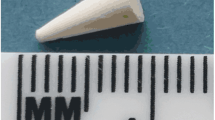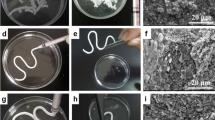Abstract
Conventional PMMA bone cement, and more lately BisGMA (bisphenol A-glycidyl methacrylate) composite bone cement, is employed in various bone augmentation procedures such as vertebroplasty. Problems with these materials include high curing exotherm and shrinkage, leakage of toxic components after insertion and exhibition of a modulus mismatch between bone cement and weak bone. A novel high molecular weight dimethacrylate, polypropylene glycol dimethacrylate (PPG), was used in combination with urethane dimethacrylate, hydroxyethyl methacrylate, silica glass particles and fibres to create PPG fibre composite (PFC) dual paste materials. This study was designed to ascertain whether PFCs are a viable alternative to Cortoss™ composite bone void filler and Simplex P™ PMMA bone cement for osteoporotic vertebroplasty and fracture fixation applications. The degree of monomer conversion and curing kinetics of the PFCs and commercial bone cements were found using FTIR, while the mechanical properties were found through biaxial flexural testing. An equation was derived to describe the curing profiles of the PFCs and commercial bone cements. The curing profiles and equations and mechanical properties of the PFCs, Cortoss™ and Simplex P™ bone cements were compared. It was found that PFC materials had more complete monomer conversion, and faster cure than Cortoss™ and Simplex P. The flexural strength of some of the PFC materials was comparable to Cortoss™ and Simplex P. Incorporating fibres into the PFC materials prevented brittle fracture exhibited by Cortoss™ and mimicking the fracture behaviour of Simplex P.





Similar content being viewed by others
References
Van Staa TP, Dennison EM, Leufkens HG, Cooper C (2001) Epidemiology of fractures in England and Wales. Bone 29(6):517–522
Lewis G, Xu H, Madigan S, Towler MR (2007) Influence of strontia on various properties of Surgical Simplex (R) P acrylic bone cement and experimental variants. Acta Biomater 3(6):970–979
Kuehn K-D, Ege W, Gopp U (2005) Acrylic bone cements: composition and properties. Orthop Clin North Am 36(1):17–28
Fries IB, Fisher AA, Salvati EA (1975) Contact dermatitis in surgeons from methylmethacrylate bone cement. J Bone Joint Surg Am 57(4):547–549
Wnek GE (2008) Encyclopedia of biomaterials and biomedical engineering 2nd (eds) , Informa Healthcare, London p 4
Lewis G (1997) Properties of acrylic bone cement: State of the art review. J Biomed Mater Res 38(2):155–182
Jiranek WA, Hanssen AD, Greenwald AS (2006) Antibiotic-loaded bone cement for infection prophylaxis in total joint replacement. J Bone Jt Surg 88(11):2487–2500
Santin M, Motta A, Borzachiello A, Nicolais L, Ambrosio L (2004) Effect of PMMA cement radical polymerisation on the inflammatory response. J Mater Sci Mater Med 15(11):1175–1180
Kane RJ, Yue W, Mason JJ, Roeder RK (2010) Improved fatigue life of acrylic bone cements reinforced with zirconia fibers RID A-9398-2008. J Mech Behav Biomed Mater 3(7):504–511
Lewis A (2009) Drug Device Combination Products Delivery Technologies and Applications. Woodhead Publishing Ltd, Sawston, p 560
Pomrink GJ, DiCicco MP, Clineff TD, Erbe EM (2003) Evaluation of the reaction kinetics of Cortoss, a thermoset cortical bone void filler. Biomater 24(6):1023–1031
Young AM, Rafeeka SA, Howlett JA (2004) FTIR investigation of monomer polymerisation and polyacid neutralisation kinetics and mechanisms in various aesthetic dental restorative materials. Biomater 25(5):823–833
Young AM, Ng PYJ, Gbureck U, Nazhat SN, Barralet JE, Hofmann MP (2008) Characterization of chlorhexidine-releasing, fast-setting, brushite bone cements. Acta Biomater 4(4):1081–1088
Chung S, Yap A, Koh W, Tsai K, Lim C (2004) Measurement of Poisson’s ratio of dental composite restorative materials. Biomater 25(13):2455–2460
Madigan S, Towler MR, Lewis G (2006) Optimisation of the composition of an acrylic bone cement: application to relative amounts of the initiator and the activator/co-initiator in Surgical Simplex P. J Mater Sci Mater Med 17(4):307–311
Sanus GZ, Tanriverdi T, Kafadar AM, Ulu MO, Uzan M (2005) Use of Cortoss for reconstruction of anterior cranial base: a preliminary clinical experience. Eur J Plast Surg 27(8):371–377
Hofmann MP, Young AM, Gbureck U, Nazhat SN, Barralet JE (2006) FTIR-monitoring of a fast setting brushite bone cement: effect of intermediate phases. J Mater Chem 16(31):3199–3206
Rueggeberg F, Tamareselvy K (1995) Resin cure determination by polymerization shrinkage. Dent Mater 11(4):265–268
Palin WM, Fleming GJ, Marquis PM (2005) The reliability of standardized flexure strength testing procedures for a light-activated resin-based composite. Dent Mater 21(10):911–919
Mehdawi I, Abou Neel EA, Valappil SP, Palmer G, Salih V, Pratten J et al (2009) Development of remineralizing, antibacterial dental materials. Acta Biomater 5(7):2525–2539
Timoshenko SP, Kreiger SW (1964) Theory of plates and shells, 2nd edn. McGraw Hill Higher Education, New York
Higgs W, Lucksanasombool P, Higgs R, Swain M (2001) A simple method of determining the modulus of orthopedic bone cement. J Biomed Mater Res 58(2):188–195
Wilson KS, Zhang K, Antonucci JM (2005) Systematic variation of interfacial phase reactivity in dental nanocomposites. Biomater 26(25):5095–5103
Karmaker A, Prasad A, Sarkar N (2007) Characterization of adsorbed silane on fillers used in dental composite restoratives and its effect on composite properties. J Mater Sci Mater Med 18(6):1157–1162
Zhang H, Zhang M (2010) Effect of surface treatment of hydroxyapatite whiskers on the mechanical properties of bis-GMA-based composites. Biomed Mater 5(5):054106
Odian G (2004) Principles of Polymerization, 4th edn. Wiley Interscience, New York
Young RJ, Lovell PA (1991) Introduction to polymers, 2nd edn. CRC Press, Boca Raton
Sideridou ID, Achilias DS, Kostidou NC (2008) Copolymerization kinetics of dental dimethacrylate resins initiated by a benzoyl peroxide/amine redox system. J Appl Polym Sci 109(1):515–524
Turi EA (1997) Thermal characterization of polymeric materials. Academic Press, New York, p 1200
Sideridou I, Tserki V, Papanastasiou G (2002) Effect of chemical structure on degree of conversion in light-cured dimethacrylate-based dental resins. Biomater 23(8):1819–1829
Abou Neel EA, Salih V, Revell PA, Young AM (2012) Viscoelastic and biological performance of low-modulus, reactive calcium phosphate-filled, degradable, polymeric bone adhesives. Acta Biomater 8(1):313–320
Tacir I, Kama J, Zortuk M, Eskimez S (2006) Flexural properties of glass fibre reinforced acrylic resin polymers. Aust Dent J 51(1):52–56
Vallittu P (1997) Oxygen inhibition of autopolymerization of polymethyl methacrylate-glass fibre composite. J Mater Sci Mater Med 8(8):489–492
Garoushi S, Vallittu P, Lassila L (2007) Short glass fiber reinforced restorative composite resin with semi-inter penetrating polymer network matrix. Dental Mater 23(11):1356–1362
Chung SM, Yap AUJ, Chandra SP, Lim CT (2004) Flexural strength of dental composite restoratives: comparison of biaxial and three-point bending test. J Biomed Mater Res Part B Appl Biomater 71B(2):278–283
Shi L, Shi L, Wang L, Duan Y, Lei W, Wang Z et al (2013) The improved biological performance of a novel low elastic modulus implant. PLoS ONE 8(2):e55015
Belkoff S, Mathis J, Erbe E, Fenton D (2000) Biomechanical evaluation of a new bone cement for use in vertebroplasty. Spine 25(9):1061–1064
Acknowledgements
This work has been supported by UCL Eastman Dental Institute, 256 Gray’s Inn Road, London WC1X 8LD, UK
Author information
Authors and Affiliations
Corresponding authors
Ethics declarations
Conflict of interest
The authors declare no conflict of interest.
Additional information
Publisher's Note
Springer Nature remains neutral with regard to jurisdictional claims in published maps and institutional affiliations.
Rights and permissions
Springer Nature or its licensor (e.g. a society or other partner) holds exclusive rights to this article under a publishing agreement with the author(s) or other rightsholder(s); author self-archiving of the accepted manuscript version of this article is solely governed by the terms of such publishing agreement and applicable law.
About this article
Cite this article
Main, K., Khan, M.A., Nuutinen, JP. et al. Evaluation of modified dental composites as an alternative to Poly(methyl methacrylate) bone cement. Polym. Bull. 80, 13143–13158 (2023). https://doi.org/10.1007/s00289-023-04677-w
Received:
Revised:
Accepted:
Published:
Issue Date:
DOI: https://doi.org/10.1007/s00289-023-04677-w




